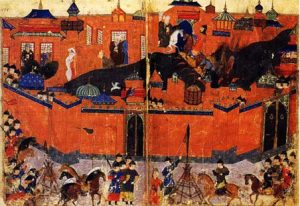
What is an empire? The Akkadian Empire: Stele of Naram-Sin (about 2200 BC)
Definition of an empire
What is an empire? An empire is like a state, only with one more layer of government. States generally have at least four levels of administration; empires have five. For example, in a state, you might have (1) a town council (2) a count (3) a duke and (4) a king. But in an empire, you might have a governor instead of a king, and then an emperor over everyone else.
States join together to make an empire
An empire is generally made up of a lot of states joined together. Sometimes these states are still mostly independent, sometimes they are totally part of the empire. The usual pattern of empires is that one state, for whatever reason, becomes stronger than its neighbors and conquers them, creating an empire. The more it conquers, the stronger it gets, and so it conquers more and more of its neighbors. (There’s also the victorious army problem).
Why does an empire stop growing?
Eventually the empire stops growing. Sometimes that’s because it hits an ocean or a mountain range that is hard to cross. Or sometimes an empire meets neighbors who are stronger than it is. But more often it’s just because it is inconvenient to fight so far from home.
Why do empires collapse into smaller states?
After some time, the empire weakens and breaks up into smaller states again. There’s really no need to explain why. It’s hard to hold an empire together, and any little problem can make it fall apart. Often, the empire hires weaker people living outside the empire as mercenaries, and then they end up invading or taking over. Sometimes they have to fight wars on two different borders at the same time, and they can’t afford it. Sometimes there’s a plague or a drought. Often the death of a leader leads to civil war. Sometimes there’s great inequality – a few very rich people and mostly very poor people – and that weakens the empire because very few people go to school, so they can’t invent things or organize things very well. Neighboring empires that have been more equal send more kids to school and develop better technology. Then they use their strength to attack unequal empires.
Where were the first empires?
The first empires were probably in West Asia, first under the Akkadians, then under the Babylonians, and then under the Assyrians. The Egyptians also had a sort of empire in the New Kingdom as they conquered Israel, Jordan, Lebanon and Syria. China had empires a little later, under the Shang Dynasty.
The Hittites also had a small empire. These empires were mainly tribute-collectors. They did not try very hard to control the activities of the states under their control.
The Persian Empire
The Persian Empire in 539 BC, in Iran, was different from any empire before it. It was more centrally controlled, thanks to good roads and a good messenger service. Like most later empires, the Persian Empire brought peace and safety. But some people who wanted to rule themselves were forced into the empire. The peace and safety of the Persian Empire and the Zhou Dynasty in China allowed increasing trade between them along the Silk Road.
Alexander to the Roman Empire
Alexander the Great eventually took over the Persian Empire, but when he died it broke up into a number of smaller states. Further east in India, Chandragupta built the first Indian empire about the same time. After about 50 BC, West Asia was dominated by the Parthian and then the Sassanian Empire and the Mediterranean Sea by the Roman Empire.

Tamerlane besieges Baghdad (Mongol Empire)
In the 400s AD, the Roman Empire broke down into smaller states again. Then in the 600s AD the Arabs conquered much of the Roman Empire and all of the Sassanian Empire and built them into the Islamic Empire.
Islamic Empire and Mongols
The Islamic Empire, like other West Asian empires before it, has a pattern of unifying and collapsing which has lasted from then until now. In Europe, no medieval power after Charlemagne succeeded in building a successor to the Roman Empire, though many Holy Roman Emperors tried. The Aztecs and Incas in the Americas built smaller empires. But in the later Middle Ages, almost all of Eurasia – from Eastern Europe to China – was unified in one gigantic empire under Genghis Khan and the Mongols.
Britain and the Holy Roman Empire
In the 1300s, the Mongol Empire collapsed too – partly because of the Black Death. The Ottoman, Safavid, and Mughal empires formed. But even bigger empires were on their way. In the Renaissance, the Holy Roman Empire and Great Britain formed huge colonial empires. Charles V controlled most of the Americas, and Britain controlled India, South Africa, and the Atlantic coast of North America.
The U.S.S.R., the United States, and China
Learn by doing: list some pros and cons of living in a big empire
More about States
And more about the Persian Empire
More about the Roman Empire
Bibliography and further reading about empires:





WHO WROTE THIS I NEED TO KNOW FOR MY SCHOOL PROJECT ABOUT DIFFERENT EMPIRES PLEASE COMMENT BACK AT LET ME KNOW THANKS!!!!!!
The citation info is right under the end of the article (above these comments). Here it is again:Carr, K.E. What is an empire? Definitions, examples. Quatr.us Study Guides, June 29, 2017. Web. May 9, 2018.
This is very poorly written and not at all accurate — like something a seventh grader would make up after looking at Wikipedia for two minutes. Get yourself a dictionary. Your definition of “empire” is just plain wrong. I really worry that students will come across a page like this on the internet and think it is scholarly.
Well, it’s pretty definitely scholarly, because I am actually a professional historian, with a doctorate and everything, and not a 7th grader. I’d be happy to consider changing anything you specifically demonstrate to be wrong, but it’s difficult to defend my article against your vague insults.